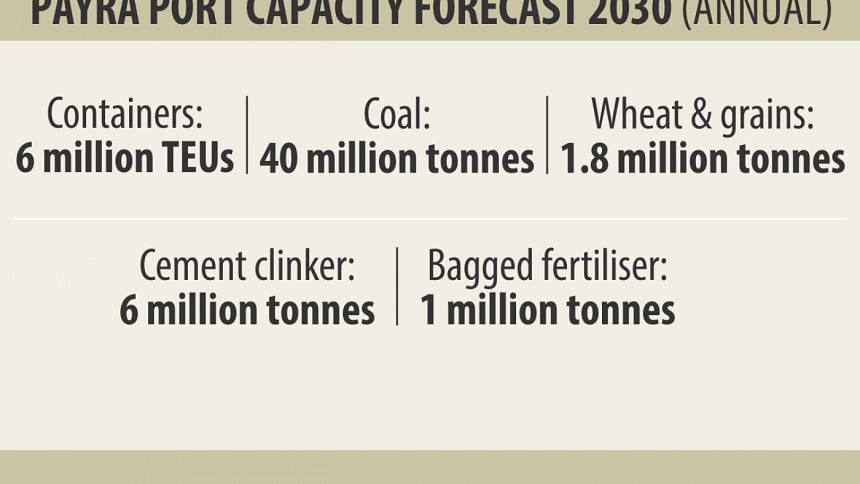High hope on Payra

Chittagong Port alone will not be able to handle the country's shipping needs in the next 15 years as the projected GDP growth dictates that the nation's container handling demand will triple by 2030.
The port now handles two million TEUs (Twenty Foot Equivalent Units) a year due to its inability to handle ships with high draught. It can only handle vessels with up to 4,000 TEU capacity. The port can at best deal with around 3 million TEUs a year.
But the country's needs are greater. In addition to container handling, the country will need huge coal imports, cement clinkers, food grain and many other materials in increasing volumes.
This is where the newly opened Payra Port will play a key role, according to an assessment of the potential market and business opportunity of Payra Port prepared by Interport BD Ltd late last year.
In the report, as part of a techno-feasibility study of the British firm HR Wallingford & consortium, Interport suggested that Bangladesh needs a deep-water port capable of handling vessels with 14.5 meters draught and 43 meters width. This will help Bangladesh handle large vessels, which it cannot do now.
“The size of vessel is required to deliver the necessary economies of scale to allow for the most efficient movement of freight to and from Bangladesh. Neither Chittagong nor Mongla offers this opportunity,” said the assessment report.
Interport prepared the report based on a combination of overall demand forecast for Bangladesh and GDP forecast up to 2045.

The leading cargo opportunity is in containers and it will grow to three million TEUs by 2020 and six million by 2030. “If the opportunity to develop container traffic to and from the Seven Sisters region of India is included, the opportunity and pressure is greater,” it said.
The report notes that using small vessels like it is being done in Chittagong Port is not an option since economies of scale are heavily in favour of larger vessels.
The country's other port, Mongla, handles just 32,000 TEUs a year. According to the report, the port will stop handling containers from 2021.
But to make Payra Port work, the government needs to link the port to Dhaka by road, waterways and railway. The report notes, “no railway=no traffic”.
Coal is forecast to be the second base cargo for the port. The assessment says that at least eight coal power plants -- including two in Rampal -- would require import of 40 million tonnes of coal a year and this will be delivered by large vessels. Payra Port will have a dry bulk terminal with rail links to deliver coal to power plants, brick kilns and cement manufacturers.
The other major dry bulk import is cement clinker. Clinker import is expected to reach 7.5 million tonnes in 2025 and 14 million tonnes in 2030.
A Liquefied Natural Gas (LNG) terminal will be built to handle import of 10 million cubic metres of LNG and there is an opportunity to develop an oil refinery in Payra, which has necessary land available to handle 3 to 4 million tonnes of crude oil per year.
The port is being prepared to handle import wheat and other grains, bagged fertiliser, steel and forest products, and cruise vessels.
The Payra Port, situated by the Rabnabad channel, will require a total of 7,000 acres of land. Of this, 6000 acres will be used for port development, 500 acres for the coal terminal and the remaining for resettlement of people affected by the construction of the port.
The port project is being implemented in 19 components demanding investment between $11 billion to $15 billion.
The Rabnabad channel is in the Meghna estuary and a part of the Tentulia river in Patuakhali. It is about 270km from Chittagong Port and 90km away from Mongla Port.
This site has been chosen as it has available land along the channel with an average height of two meters above sea level. The land does not submerge during monsoon and it is well connected by road and river.

 For all latest news, follow The Daily Star's Google News channel.
For all latest news, follow The Daily Star's Google News channel. 



Comments